
IT'S been a long time coming, this new Volkswagen Amarok.
This article was first published in 4x4 Australia's July 2011 issue.
Word leaked out three or four years ago that the established and respected German company was working on a challenger for the hotly contested ute market, especially the dual-cab segment. Even with respected road-car credentials, it was seen as a bold move by VW to move into a market dominated by Japanese manufacturers.
That was viewed both as a plus and a minus by people like us; the plus is the fact VW could ‘clean-sheet’ the vehicle and not suffer from the restrictions and hangovers of a previous model or production facilities. In other words, it could do whatever it thought necessary to create a brand-new, brilliant design.
 The minus is the fact that, with no presence in the dual-cab market, it had no starting point, no vehicle from which to glean experience. Sure, VW had its king Kombi – including a dual-cab version – but that was a long time ago… But now that the Amarok is here, it’s obvious it has been worth the wait.
The minus is the fact that, with no presence in the dual-cab market, it had no starting point, no vehicle from which to glean experience. Sure, VW had its king Kombi – including a dual-cab version – but that was a long time ago… But now that the Amarok is here, it’s obvious it has been worth the wait.
That clean-sheet design opportunity wasn’t wasted by VW, and I’m happy to tell you up-front that what VW has come up with is sensational. Of the 4X4 Australia contributors, Matho (Mick Matheson) was the first to give it a go, driving some lightly modified Dakar rally support Amaroks last year.
With the usual “We’ll wait ’til it gets here,” reservation of sensible motoring journos, he gave it a solid thumbs-up. Matt Raudonikis was next, the first feller here to have a lash over local terrain and, although he drove it in closely controlled conditions on a VW-set test loop, he also praised its comfort, dynamics and ability.
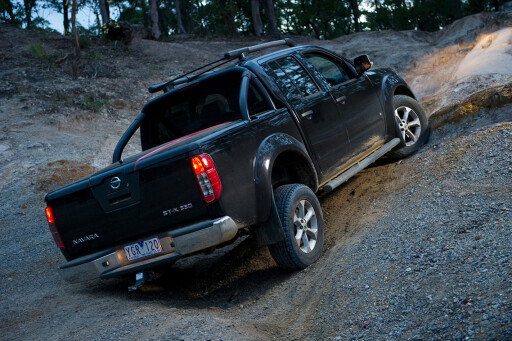 So it was with a sense of anticipation that we grabbed our first Amarok that we could take anywhere, do anything with, and see what it was like in our usual real-world test conditions. Corralled with the $52,990 (list) Amarok Highline for this off-road drive was Mitsubishi’s Triton GLX-R and Nissan’s new Navara ST-X 550.
So it was with a sense of anticipation that we grabbed our first Amarok that we could take anywhere, do anything with, and see what it was like in our usual real-world test conditions. Corralled with the $52,990 (list) Amarok Highline for this off-road drive was Mitsubishi’s Triton GLX-R and Nissan’s new Navara ST-X 550.
Billed as “Australia’s most powerful tradie”, the ST-X 550 is the new top-line version of the big-bodied, US-styled, Spanish-built (some models are sourced from Thailand) D40 series that debuted in the mid-noughties.
The 550 refers to torque output of the recently introduced 170kW single turbo ‘Alliance’ 3.0-litre V6 diesel that Nissan also installs in the Pathfinder (and may appear in the next-gen Patrol). It’s mated to a seven-speed gearbox with a sports mode, manual shift and in Navara, a part-time four-wheel drive system with traction/stability control and rear LSD.
It’s $60,990. The last of our trio is Mitsubishi’s Triton GLX-R. Triton has a 2.5-litre turbo-diesel with 131kW and 400Nm in manual form (350 auto) and its Super Select transfer which allows full-time 4X4 and 2WD, and 4X4 in high- and low-range.
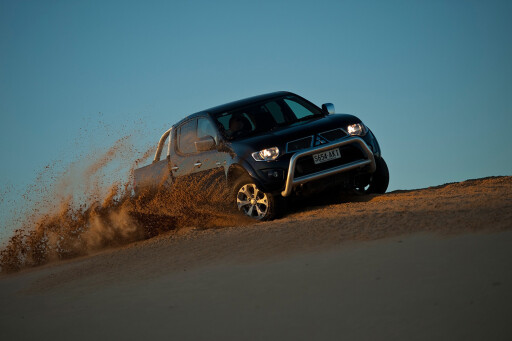 Thanks to its blend of ability, safety and value, Triton is 4X4 Australia’s reigning Ute of the Year (two years running!) so is a great benchmark for price ($47,990) and performance. There’s an auto on the horizon but, for now, Amarok has a six-speed manual behind a 120kW, 400Nm 2.0-litre bi-turbo four-cylinder diesel.
Thanks to its blend of ability, safety and value, Triton is 4X4 Australia’s reigning Ute of the Year (two years running!) so is a great benchmark for price ($47,990) and performance. There’s an auto on the horizon but, for now, Amarok has a six-speed manual behind a 120kW, 400Nm 2.0-litre bi-turbo four-cylinder diesel.
Our test Amarok was third up the four-model ladder, a Highline. It arrives with VW’s selectable 4Motion dual-range drivetrain that includes a selectable Off-Road mode. The top-spec Amarok Ultimate has the option of VW’s permanent 4Motion system which lacks low-range, but all 4X4 models receive a rear diff lock rather than an LSD.
We reckon the Highline with its quality cloth trim and dual-range selectable 4Motion system will be the big seller for family buyers. Ultimate has leather seats, 19-inch wheels and a host of other comfort kit. VW’s marketing information babbles on about the style of the new ute; sentences with phrases like “surfaces that develop over the contours”, and other such nonsense.
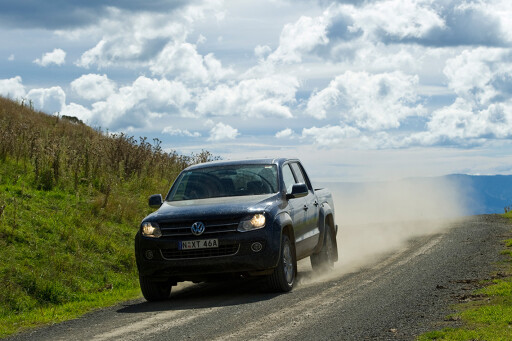 It also pushes the VW’s safety credentials hard; most car companies do it when a new vehicle comes along; and why wouldn’t they? After years of work and development, they have a product to sell and need to catch people’s attention. The team at VW can feel proud.
It also pushes the VW’s safety credentials hard; most car companies do it when a new vehicle comes along; and why wouldn’t they? After years of work and development, they have a product to sell and need to catch people’s attention. The team at VW can feel proud.
This is a damn fine-looking truck with great stance and proportions. Its purposeful appearance is free of gimmicks and clichés, and manages to tone down the sheer size of the vehicle. Make no mistake, the VW Amarok is a big and roomy vehicle (more on that later).
Volkswagen Amarok vs Ford Ranger: Video review
In fact, the no-nonsense appearance of the new VW makes the Mitsubishi Triton – a vehicle praised for its radical, break-free styling when it was launched around 2005 – look almost silly. All those curves and swoops for no benefit apart from looking radical.
In the VW, form follows function and it’s apparent that the design team and engineers worked from the inside (and the load tray) out, making it look good after making it comfortable and useful.
GETTING COMFORTABLE
So that’s where we’ll start: on the inside. The VW’s driving position – and here I go with the clichés – is a revelation.
Of course, it’s no more car-like than , ahem, a well-done car, but the relationship between wheel (with tilt and reach) and pedals feels almost perfectly natural and relaxed, and is a giant leap for utekind. It makes the Mitsubishi, in particular, feel crook. The seat elevation makes Amarok easy to get in and out of, too, and allows a good view ahead.
The seat has just the right amount of firmness and has just enough wrap-around to hold you without being too assertive. In contrast, the Nissan’s seats, although large, are hard and flat, while the Mitsubishi’s feel small and under-done. Neither offers much in the way of support.
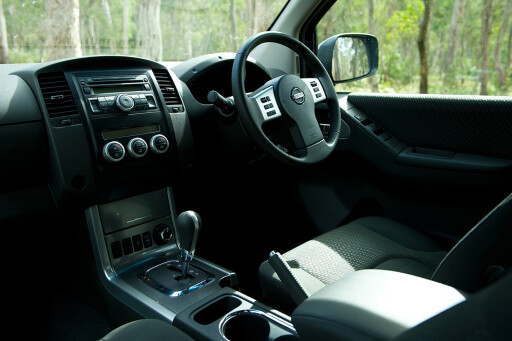 At least Mitsubishi seems to have corrected the rocking that afflicted Tritons, but the lever-actuated backrest rake might leave some drivers wishing for a half-click more or less rake. Rear seating is an important factor for many dual-cab buyers; particularly families who have higher expectations of comfort than, say, three blokes being driven a few kays to their bulldozers.
At least Mitsubishi seems to have corrected the rocking that afflicted Tritons, but the lever-actuated backrest rake might leave some drivers wishing for a half-click more or less rake. Rear seating is an important factor for many dual-cab buyers; particularly families who have higher expectations of comfort than, say, three blokes being driven a few kays to their bulldozers.
Amarok has easily the largest rear seat of the three. The backs of its front seats are scalloped to give back passengers more knee room, there is more footroom and a lower floor (or higher seat). All three passengers have a headrest, too. The Mitsubishi prompted the cheeky comment of “at least we’re not going to get cold!” when we loaded three testers into it.
The outer passengers felt inclined to tilt their heads inwards from the upper cant rail; the centre seat cushion is hard. Although it’s out-bummed by the VW (it’s 100mm or so wider) the Nissan’s rear seating scores well for its overall comfort – cushion, height, and knee and foot room.
 And when it’s not being used for carrying passengers, the rear half of the Nissan cabin is more useful for carrying gear thanks to the fact the seat cushion can be lifted. Doing so tucks it and the backrest against the rear wall of the cab and presents a relatively flat area for a fridge or boxes. It’s simple and effective.
And when it’s not being used for carrying passengers, the rear half of the Nissan cabin is more useful for carrying gear thanks to the fact the seat cushion can be lifted. Doing so tucks it and the backrest against the rear wall of the cab and presents a relatively flat area for a fridge or boxes. It’s simple and effective.
Bonus: there’s netted storage trays under there, too. It’s worth mentioning, as VW proudly does, the fact the Amarok achieves ANCAP’s top safety score of five stars, giving it the thumbs up for family and fleet buyers. That’s due to a beaut chassis design, sophisticated chassis electronics package (that also assists with off-road ability; more later) and a swag of airbags.
It wasn’t too long ago that an airbag was the be-all and end-all in vehicle safety with advertising campaigns featuring images of pillow-like objects…
ON THE BLACK STUFF
Our drive loop was to take in a broad range of conditions, from blacktop (of course) to beach sand, dirt roads and some stiff off-road stuff, to really show strengths and highlight weaknesses in each vehicle’s ability. But first, they’re all designed to carry stuff, and it’s the VW that impressed overall with its tray.
It’s deeper (45cm) and wider (150cm) than the status quo, but loses 50mm to the Navara and Mitsubishi in length. The four tie-down hooks are usefully placed near each corner to keep loads in check. Of course, they’re not as versatile as Nissans’ Utili-Track system of moveable clamps… but not as bulky or fiddly, either.
Our VW was delivered without any bed protection, so factor that into the budget, along with a hard cover if you want to mimic the Nissan’s. Oh, and why don’t all utes have load area lighting and a 12V socket? Testing utes empty is like testing a fast car slowly, so, as pioneered in our 4X4UOTY testing some years ago, we loaded each vehicle.
Two hundred kilos of bagged sand was dropped into each tray to replicate a typical moderate load (big thanks to Drinkwater Landscape Supplies near my place in Redhead, NSW, for that!) and to not only settle the ride compared to unladen, but give the suspension something to do as well.
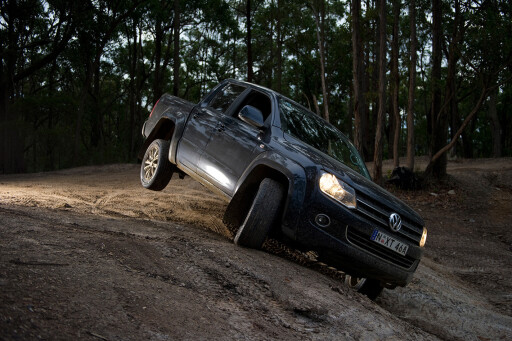 VW seems to have got its suspension right, first time. There’s nothing truly innovative underneath, but what is there is sensibly and stoutly engineered. Up front, the VW has upper and lower wishbones with coil springs, and out back, a live axle and leaf springs.
VW seems to have got its suspension right, first time. There’s nothing truly innovative underneath, but what is there is sensibly and stoutly engineered. Up front, the VW has upper and lower wishbones with coil springs, and out back, a live axle and leaf springs.
Where VW improves on the norm is with the engineering of its rear; the springs are eyed on huge rubber bushes with the rear shackle not only inverted, but installed on the outboard side of the chassis rail, rather than underneath it. This allows the chassis to be lowered, providing a deeper tray and, by splaying out the rails under the cabin, it has space benefits inside, too.
Further helping the chassis is a substantial rear cross member. The Amarok’s thorough suspension design obviously allowed it to shoulder the load with greater stamina. Sure, 200 kegs isn’t that much weight, really, but from the first few kays it’s enough to be noticeable from the driver’s seat in the Nissan and Mitsubishi; both bobbing and flustering, rather than remaining composed like the VW.
The Mitsubishi tires first; is it something to do with those needle-thin dampers? The VW’s new two-snailed 2.0-litre engine is as delightful as the Nissan’s is disappointing. The Nissan has a lovely rollicking idle, but we were underwhelmed by the Pathfinder’s alleged 550Nm during 4X4OTY testing last year, and the Navara is the same.
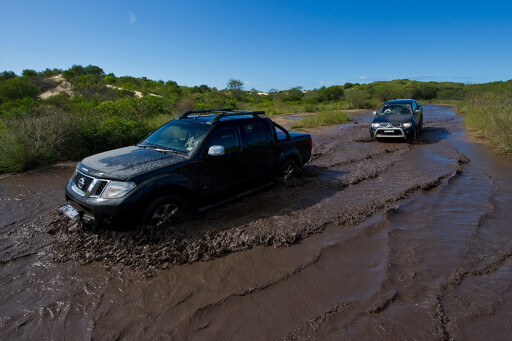 In short, it doesn’t offer the wham expected of an engine with the twist and stout of a Jeep Grand or Disco 4. And the trans calibration is frustrating; it swaps cogs when you don’t want it too, and doesn’t change when you do. Sport mode doesn’t seem to make any difference.
In short, it doesn’t offer the wham expected of an engine with the twist and stout of a Jeep Grand or Disco 4. And the trans calibration is frustrating; it swaps cogs when you don’t want it too, and doesn’t change when you do. Sport mode doesn’t seem to make any difference.
Cruising revs are 1750rpm at 100km/h… exactly the same as the VW, which is two-thirds the size. The Mitsubishi is a few hundred revs more, which adds to the wind noise and overall higher levels of din in the cabin. The new VW engine is a forthright performer in most conditions, but for a window of maybe 200rpm above idle, where it has a torque gap before the whole torque of 400Nm arrives.
Every driver stalled the VW several times on this test and, although we all got used to it, we also got used to the whiff of clutch. It’s something that may trouble a driver who’s stepped straight from a HiLux diesel. The VW’s manual shift is de-coupled from the box it controls to reduce the noise it may transmit into the cabin, but it’s also often tricky to snick into gear.
Swapping from vehicle to vehicle, our drivers considered the Mitsubishi’s 2.5-litre engine and five-speed manual less refined, more peaky and with bigger gaps between the cogs (obviously), but it gets on with the task in an honest, tradesman-like manner. There’s not much more to be said there.
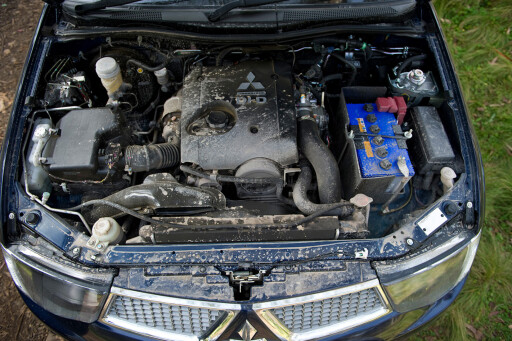 Handling and road holding are a clear win to the VW. The engine is always on-song, therefore an asset to progress, and the handling predictable and playful. It doesn’t get knocked around by potholes or broken surfaces as much as the other two here. Steering is crisp and communicative, with the first few degrees of wheel twirling getting you an instant response, so it’s easy to correct the VW’s course with subtlety.
Handling and road holding are a clear win to the VW. The engine is always on-song, therefore an asset to progress, and the handling predictable and playful. It doesn’t get knocked around by potholes or broken surfaces as much as the other two here. Steering is crisp and communicative, with the first few degrees of wheel twirling getting you an instant response, so it’s easy to correct the VW’s course with subtlety.
In contrast, the Nissan feels disconnected until it loads up in corners, where it’s thrown around more than the supple VW; the Mitsubishi’s steering is lazy and lumpy and the ride firm which, with the floaty rear suspension, keeps you busy with corrections.
Continuing our frustration with the Nissan’s driveline is the fact that in hilly, winding terrain it conspires against the driver keeping a smooth, flowing pace. An engine of this prodigious output should waft along on a wave of torque… or if it can’t do that, a premium performance engine should be responsive to gear and/or throttle.
The Nissan does neither. VW says its Amarok is the most fuel efficient in its class, claiming 7.9L/100km for the 4X4 models in the ADR combined cycle. Our tough testing didn’t deliver figures anywhere near this claim, showing 12.6L/100km for our varied terrain, which included a session on sand.
 Oddly, our test Triton’s odometer showed a huge disparity with the other two vehicles, reading nearly 15 percent optimistic compared to the other two’s average, despite being driven in convoy with them.
Oddly, our test Triton’s odometer showed a huge disparity with the other two vehicles, reading nearly 15 percent optimistic compared to the other two’s average, despite being driven in convoy with them.
As its fuel use was within a teaspoon of the Amarok’s over the same distance, we’re sure it was an erroneous odometer and we’ve corrected its consumption figure using the average of the other two vehicles. The Triton’s corrected figure is 12.9L/100km.
VW may crow about its class-leading fuel efficiency, but it’s Nissan that deserves to be happy: Despite our criticisms of its trans calibration and driveability, its big-output 3.0-litre V6 impressed, being within one litre per 100km of the other two. Good stuff.
OFF-ROAD
Okay, so the Amarok is convincingly competent on-road, but what does it do away from it? Well, we’re happy to say it backs up its on-road prowess with almost formidable ability off it, thanks to good, basic hardware and a sophisticated electronics/traction package.
The VW has an almost aftermarket level of protection installed by the factory. It keeps its components out of harm’s way with items like brake lines and wiring harnesses all well-routed and tethered.
Of note is the sump guard; it’s capable of withstanding the weight of the vehicle as it’s being ‘groined’ over a log or high crown, so protects well from terrain damage – something that we know the Nissan is vulnerable to from bitter experience. The Mitsubishi is marginal underneath, too.
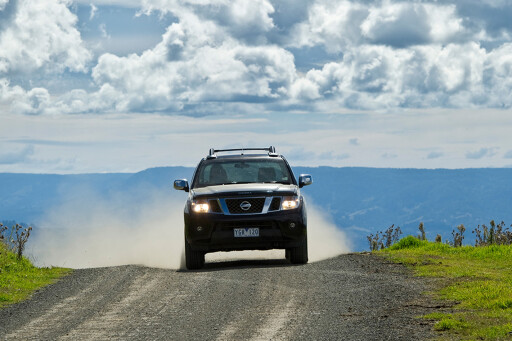 After its lethargy on-road, the Nissan seems to wake up on sand; those Newton metres get to work when the black turns to track. But get around that torque pothole and it’s the Amarok that feels the most lively and nimble on the beach.
After its lethargy on-road, the Nissan seems to wake up on sand; those Newton metres get to work when the black turns to track. But get around that torque pothole and it’s the Amarok that feels the most lively and nimble on the beach.
There’s a few flashes from the (switchable, as all are on this test) electronic nanny, but little in the way of momentum-robbing intervention, which the Mitsu seems to suffer from the most. But it’s the swag of smart software that gives the VW its (dare I say it?) all-conquering off-road ability.
More 4x4 Australia road tests
The Aussie dual-cab buyer is only just getting used to traction control as an asset in arduous terrain; Amarok adds chassis electronics to a diff lock to offer unflustered Land Rover Discovery-like levels of ability. Off-Road Mode tweaks the electronics for better off-road performance.
It has hill descent control that works in reverse; the system is intuitively tuned by applications to the brake and throttle, rather than steering wheel buttons; the brakes release softly after the brake pedal is let go. These characteristics offer new levels of confidence to beginners (not always a good thing, we know) and enhanced safety for experienced drivers.
.jpg ) Our final fling for this test was in a disused quarry that 4X4 often uses for direct comparisons of drivelines and systems. With the Amarok brushing-off every other exercise we’d asked of it, success in this terrain was a no-brainer. The systems are so seamless and well-tuned, you can barely feel them working.
Our final fling for this test was in a disused quarry that 4X4 often uses for direct comparisons of drivelines and systems. With the Amarok brushing-off every other exercise we’d asked of it, success in this terrain was a no-brainer. The systems are so seamless and well-tuned, you can barely feel them working.
You can sum it up in one sentence: Nothing stopped the Amarok. Put simply, the new VW Amarok offers a breadth and depth of on-and off-road ability and comfort that raises the bar for the dual-cab ute brigade. One thing is for sure, 4X4 Australia’s annual Ute of the Year test is going to be one helluva battle!

COMMENTS